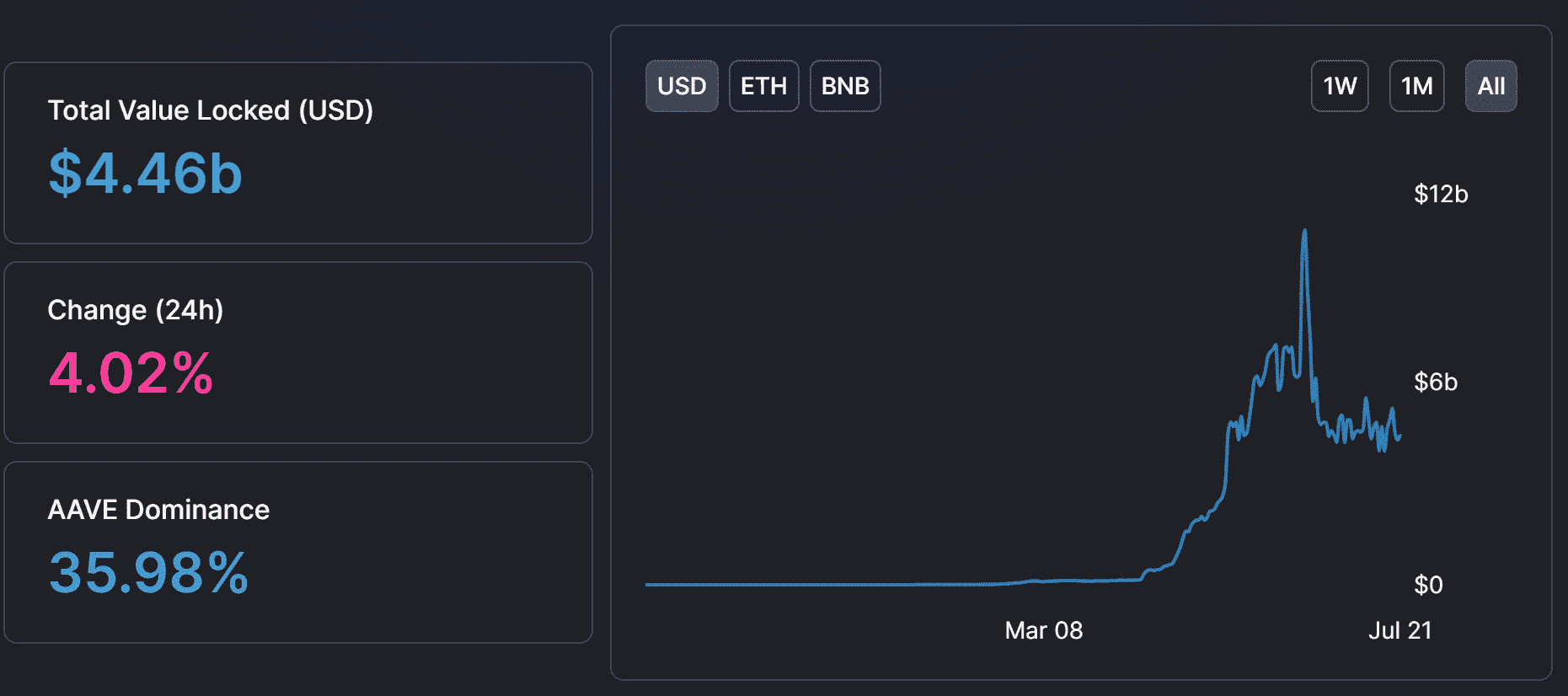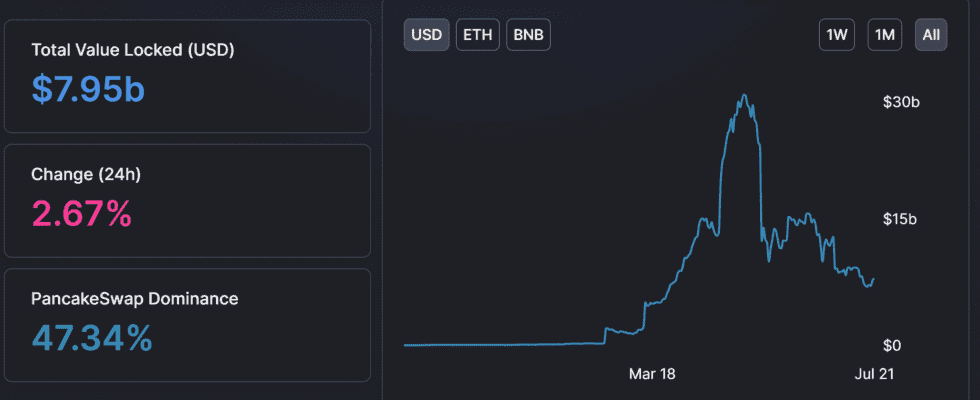The duel of scaling solutions for Decentralized Finance (DeFi) on Ethereum (ETH) has only just begun. In addition to Polygon, Optimism is now also being launched and Arbitrum will follow in a few weeks – but what exactly is behind the various ETH scaling solutions?
At the beginning of this year, excessively high ETH transaction costs meant that more and more DeFi users were turning their backs on Ethereum. For a short time, the trading volume of the decentralized exchange (DEX) PancakeSwap (CAKE) based on the Binance Smart Chain (BSC) even exceeded that of Uniswap.
When many DeFi projects adopted Polygon’s Ethereum scaling solution at the end of April, the Total Value Locked (TVL) of the BSC DeFi space sank rapidly.
The capital in the smart contracts of BSC DeFi projects fell from almost 30 billion to 7.95 billion US dollars at the time of going to press. During the same period, Polygon’s TVL increased more than 4,000 percent. The Ethereum scaling solution now has a TVL of $ 4.46 billion.



Polygon has shown that Ethereum can be scaled. However, polygon also has its disadvantages – and not all DeFi applications rely on the scaling solution. For example, it is criticized that Polygon is too centralized and insecure. For this reason, among other things, projects like Optimism and Arbitrum are working on completely different approaches to scale Ethereum. So today we want to take a look at how the three scaling solutions differ from one another.
Polygon scales DeFi
Technically speaking, a polygon is a sidechain and not a layer 2 scaling solution like Arbitrum or Optimism. Layer 2 scaling solutions are defined by the fact that they are completely secured by the Ethereum mainchain. Sidechains, on the other hand, are blockchains that run parallel to the Ethereum mainchain and therefore have to take care of their security themselves.
The Polygon sidechain is therefore a blockchain that is completely independent of the Ethereum mainchain. But since it uses the same virtual machine as Ethereum, it can communicate with the Ethereum mainchain. This makes it possible for smart contract applications to be outsourced directly to Polygon, which means that DeFi applications can also be scaled.
In addition, Polygon uses a proof-of-stake consensus mechanism (PoS) in which validators have to deposit matic tokens in order to operate nodes, validate transactions and secure the sidechain.
At the moment, users have several options for using Polygon.
However, the most widely used option is the so-called Polygon Bridge. This enables ETH, ERC-20 tokens and ERC-721 tokens from Ethereum to be transferred to the Polygon sidechain. At the moment, deposits to Polygon via the Polygon Bridge can take up to three hours.
Once there, you benefit from the extremely low transaction costs of the polygon network. In addition, transferred tokens can be used in all decentralized applications supported by Polygon. To carry out transactions on the Polygon sidechain, however, you need a small amount of Matic and you cannot pay with ETH.
If you want to withdraw your assets back to the Ethereum mainchain, you can do the same about three hours last.
Disgruntled polygon users often criticize the long transfer times and the lack of security of the sidechain. The latter in particular is repeatedly criticized by crypto enthusiasts because a large part of the polygon network is in the In the hands of a few actors.
What are Arbitrum and Optimism doing differently?
Arbitrum and Optimism are widely recognized by the Ethereum community as the most promising scaling solutions for DeFi. This is because they use so-called Optimistic Rollups, which are also seen by Vitalik Buterin as the logical scaling bypass valve for Ethereum.
Optimistic Rollups combine several transactions into a single transaction, process them outside of the Ethereum blockchain and then only transmit the transaction data back to the Ethereum mainchain.
The name Optimistic Rollups comes from the fact that the transaction data transmitted back is not initially checked. Transactions are transmitted on the assumption that Aggregators (“block producers in the optimistic rollups ecosystem”) work without cheating.
However, if fraud does occur, the aggregators must provide evidence of the correctness of a transaction. If there are discrepancies and aggregators confirm fraudulent transactions, they automatically receive a penalty (loss of their deposited funds) and the fraudulent transaction is “rolled back”. Conversely, they will receive staking rewards for properly processed transactions. These two mechanisms are designed to prevent malicious actors from submitting false transactions.
Overall, with Optimistic Rollups, Ethereum transactions can be reduced by 10 to 50 times. Another advantage of Optimistic Rollups is that they can be implemented relatively easily in existing smart contracts.
What is the difference between Optimism and Arbitrum?
Arbitrum and Optimism have a lot in common as both scaling solutions rely on Optimistic Rollups. However, if you delve deeper into the matter, you quickly discover that they differ significantly from one another in a certain point.
Namely when it comes to how to deal with fraudulent transactions in the network. Optimism sends the entire suspicious transaction again through the Ethereum Virtual Machine (EVM), whereas Arbitrum processes the suspicious transactions offchain and only sends the suspicious part within a transaction back to the EVM. This allows Arbitrum to be a higher transaction capacity achieve as optimism.
In addition, users of Optimism and Arbitrum transactions have to pay in contrast to Polygon as well as on the Ethereum mainchain in ETH. This is because the two scaling solutions based on Optimistic Rollups are built directly on the Ethereum mainchain in smart contracts and do not use their own blockchain.
One disadvantage of Optimistic Rollups is that both Arbitrum and Optimism transactions can be held and challenged for a week. The purpose of this is to avoid fraud, but as a result of it up to seven days can take time if you want to transfer your digital assets back to the Ethereum mainchain.
